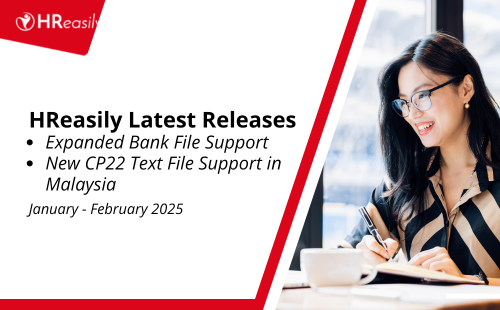
Effective claims management is an essential function in HR, guaranteeing the efficient, fair, and compliant resolution of employee concerns. To help HR professionals navigate this complex landscape, we’ve outlined 5 best practices for effective claims management. Furthermore, we’ll showcase how HReasily, an advanced HR management system, can significantly improve the claims management process.
5 Claims Management Best Practices:
1.Clear and Comprehensive Policies
Well-defined claims policies serve as a foundational component of a well-structured claims management system. These policies are comprehensive sets of guidelines, rules, and procedures that cover every aspect of the claims process, starting from the initial claim submission and extending through to its resolution. Let’s look at why well-defined claims policies are essential:
- Clarity and Transparency: These policies offer a clear and transparent roadmap for both employees and HR professionals. They provide a step-by-step understanding of how claims are handled within the organisation, reducing ambiguity and confusion.
- Consistency: Well-defined policies ensure that claims are treated consistently across the board. When everyone follows the same set of rules and procedures, it minimises the risk of bias or favouritism, fostering a fair and equitable claims management process.
- Compliance: Claims policies are designed to align with local, state, and federal regulations. By adhering to these policies, organisations can maintain legal compliance, reducing the risk of legal disputes or penalties.
- Efficiency: Clear policies simplify the claims process. Employees know exactly what information to provide, how to submit a claim, and what to expect in terms of response times and resolution. This efficiency benefits both employees and HR teams, reducing the time and effort required to process claims.
- Responsibility and Accountability: These policies assign specific responsibilities to employees and HR professionals at various stages of the claims process. This accountability ensures that all stakeholders understand their roles and can be held responsible for their actions.
- Communication: The policies often outline communication expectations, detailing how and when stakeholders should be informed about the progress of their claims. This transparent communication fosters trust and minimises misunderstandings.
- Training and Onboarding: Claims policies serve as valuable training and onboarding materials for new employees. They help familiarise newcomers with the organisation’s claims management process, ensuring that they can navigate it effectively from the start.
HReasily‘s centralised platform for storing and communicating comprehensive claims policies plays a pivotal role in streamlining the claims management process. The platform provides a secure and easily accessible repository where HR professionals can house these policies. This centralisation simplifies policy management, allowing for easy updates and revisions to reflect changing regulations or organisational needs.
2. Streamlined Reporting Procedures
Encouraging prompt reporting of workplace incidents or issues is a fundamental aspect of effective claims management. Timely reporting is crucial for several reasons, primarily because it allows organisations to address and resolve problems swiftly, reducing the risk of claim escalation.
- Preventing Escalation: Many workplace issues can start as minor concerns but escalate into more significant problems if not addressed promptly. Encouraging employees to report incidents as soon as they occur allows HR professionals to intervene at an early stage, often resolving issues before they intensify.
- Gathering Accurate Information: Reporting issues promptly ensures that the details are fresh in the minds of those involved. This typically results in more accurate and comprehensive information, which is invaluable for efficient claims processing and decision-making.
- Preventing Further Harm: In cases involving workplace accidents or health-related claims, timely reporting is critical for providing immediate medical attention or support to the affected employee. Delayed reporting could lead to a worsening of the employee’s condition, which is undesirable for both the employee and the organisation.
- Legal and Compliance Requirements: In certain industries, there are legal requirements for prompt incident reporting. Failing to meet these requirements can lead to legal consequences, fines, or regulatory issues. Simplifying the reporting process helps ensure compliance with these requirements.
- Reducing Administrative Burden: A streamlined reporting process makes it easier for employees to submit claims. This not only encourages prompt reporting but also reduces the administrative burden on both employees and HR professionals, making the process more efficient.
3. Thorough Documentation
Comprehensive documentation is a cornerstone of effective claims management within an organisation. It encompasses a variety of records, including incident reports, medical documentation, and communication between relevant parties. The importance of such comprehensive documentation in the context of claims management is multifaceted, and it plays a vital role in ensuring claim validation and compliance.
- Claim Validation: Comprehensive documentation serves as the backbone for validating the authenticity and legitimacy of claims. Incident reports, for instance, provide a detailed account of what transpired, while medical records offer evidence of the claimant’s injury or medical condition. These records help HR professionals evaluate the validity of a claim and make informed decisions.
- Transparency and Trust: Maintaining thorough documentation fosters a transparent claims management process. When employees see that their claims are handled with care and attention to detail, it builds trust within the organisation. Clear, well-kept records demonstrate a commitment to fairness and accountability.
- Legal and Regulatory Compliance: Many jurisdictions and regulatory bodies require organisations to maintain comprehensive records of claims. Failing to do so can result in legal consequences, fines, and compliance issues. Accurate and organised documentation ensures that an organisation remains compliant with these legal and regulatory obligations.
- Efficient Resolution: Having all the necessary documentation readily available expedites the claims resolution process. HR professionals can access relevant information quickly, facilitating timely decision-making and action. This efficiency benefits both employees and the organisation.
- Dispute Resolution: In the event of disputes or audits, comprehensive documentation provides an evidentiary trail. It allows HR professionals to address concerns and present facts, reducing the likelihood of escalated disputes and legal challenges.
- Risk Mitigation: Comprehensive documentation serves as a risk mitigation strategy. It minimises the potential for fraudulent or exaggerated claims, protecting the organisation’s resources and reputation.
HR professionals can rely on HReasily‘s document management features to securely store and organise all claim-related documents, making them easy to access. This organised approach helps maintain accurate records, which is crucial for quick and efficient claims processing. By using HReasily’s document management capabilities, organisations can improve their claims management process, ensuring transparency, trust, and efficiency, while reducing the risk of issues related to incomplete or missing documentation.
4. Data Analysis and Reporting
Data analysis is a critical component of effective claims management, playing a pivotal role in identifying trends and areas that require improvement. It is the process of examining claims-related data to extract meaningful insights, patterns, and correlations. Let’s look on the significance of data analysis in claims management:
- Trend Identification: Data analysis enables HR professionals to identify recurring patterns or trends in claims. For instance, it may reveal that a particular type of injury is happening frequently within the organisation. Identifying such trends is the first step in addressing and mitigating the root causes.
- Risk Assessment: By scrutinising data, organisations can assess potential risks associated with specific claims. This includes evaluating the likelihood of similar incidents occurring in the future and their potential impact on the organisation.
- Efficient Resource Allocation: Data analysis helps organisations allocate resources more efficiently. For instance, if a particular issue arises frequently, HR professionals can allocate resources to address it proactively, rather than reactively.
- Data-Driven Decisions: Analysing data empowers HR professionals to make informed, data-driven decisions regarding claims management. Rather than relying on intuition or anecdotal evidence, they can base their decisions on concrete data, which typically leads to better outcomes.
- Continuous Improvement: Identifying areas for improvement is essential for refining the claims management process. Data analysis highlights where changes are needed, allowing organisations to implement enhancements that lead to more effective and efficient claims management over time.
- Preventing Recurrence: By recognising patterns in data, HR professionals can develop strategies to prevent the recurrence of specific types of claims. For example, if data shows a pattern of workplace injuries, they can implement safety measures or training programs to address the issue at its root.
HR professionals can use HReasily to study claims data and discover trends, helping them make better decisions. This approach leads to more efficient claims management by addressing problems at their core. It also makes the process transparent, effective, and responsive, reducing risks and costs and improving the well-being of the organisation and its employees.
5. Continuous Improvement
Embracing a culture of continuous improvement involves fostering an environment within an organisation where the claims management process is seen as a dynamic and evolving entity. Here’s why this culture is essential:
- Adaptability: A continuously improving culture allows an organisation to adapt to changing circumstances. As organisational and employee needs evolve, claims management practices must also evolve to meet these new requirements.
- Efficiency: Continuous improvement often leads to more efficient processes. By regularly reviewing and optimising the claims management process, organisations can eliminate inefficiencies and streamline operations.
- Employee Engagement: Employees are more likely to engage with a process they see as adaptable and responsive to their needs. This can enhance overall employee satisfaction and involvement in the claims management process.
- Risk Mitigation: Evolving the claims management process helps organisations stay ahead of potential risks or challenges. By proactively addressing issues, they can reduce the likelihood of escalated disputes, compliance breaches, or legal complications.
- Enhanced Customer Service: Employees, in this case, are the “customers” of the claims management process. Continuous improvement ensures that their needs are met efficiently, resulting in better customer service and satisfaction.
- Innovation: Encouraging a culture of continuous improvement can lead to the adoption of innovative solutions and technologies that make the claims management process more effective and user-friendly.
With HReasily, organisations can easily embrace a culture of continuous improvement in claims management. The platform regularly updates to meet HR and claims management needs. HR professionals can adapt practices by using the latest features, ensuring an effective, compliant, and user-friendly claims management process. This enhances the organisation’s well-being and employee satisfaction.
Effective claims management is vital for HR departments and organisations. Adhering to these five best practices is the key to maintaining a seamless, efficient, and legally compliant process. HReasily, equipped with comprehensive features and a user-friendly interface, significantly supports HR professionals in simplifying their claims management procedures. Utilising HReasily empowers you to handle claims with confidence, ensuring legal compliance and delivering a transparent, efficient experience for your employees, ultimately nurturing a productive and healthy work environment.
Let’s aim for more efficient claims management in your organisation. Try HReasily 30-day trial today !
Prefer a personalised solution? Worry not, our representative can assist you. Email us at [email protected] and share with us your concerns!










